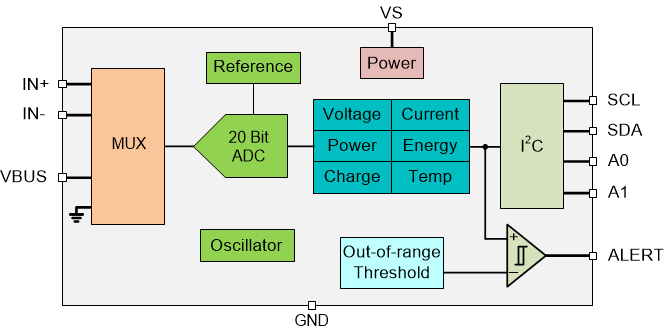-
INA228 85-V, 20-Bit, Ultra-Precise Power/Energy/Charge Monitor With I2C Interface
- 1 Features
- 2 Applications
- 3 Description
- 4 Revision History
- 5 Pin Configuration and Functions
- 6 Specifications
-
7 Detailed Description
- 7.1 Overview
- 7.2 Functional Block Diagram
- 7.3 Feature Description
- 7.4 Device Functional Modes
- 7.5 Programming
- 7.6 Register Maps
- 8 Application and Implementation
- 9 Power Supply Recommendations
- 10Layout
- 11Device and Documentation Support
- 12Mechanical, Packaging, and Orderable Information
- IMPORTANT NOTICE
Package Options
Mechanical Data (Package|Pins)
- DGS|10
Thermal pad, mechanical data (Package|Pins)
Orderable Information
INA228 85-V, 20-Bit, Ultra-Precise Power/Energy/Charge Monitor With I2C Interface
1 Features
- High-resolution, 20-bit delta-sigma ADC
- Current monitoring accuracy:
- Offset voltage: ±1 µV (maximum)
- Offset drift: ±0.01 µV/°C (maximum)
- Gain error: ±0.05% (maximum)
- Gain error drift: ±20 ppm/°C (maximum)
- Common mode rejection: 154 dB (minimum)
- Power monitoring accuracy:
- 0.5% full scale, –40°C to +125°C (maximum)
- Energy and charge accuracy:
- 1.0% full scale (maximum)
- Fast alert response: 75 μs
- Wide common-mode range: –0.3 V to +85 V
- Bus voltage sense input: 0 V to 85 V
- Shunt full-scale differential
range:
±163.84 mV / ±40.96 mV - Input bias current: 2.5 nA (maximum)
- Temperature sensor: ±1°C (maximum at 25°C)
- Programmable resistor temperature compensation
- Programmable conversion time and averaging
- 2.94-MHz high-speed I2C interface with 16 pin-selectable addresses
- Operates from a 2.7-V to 5.5-V
supply:
- Operational current: 640 µA (typical)
- Shutdown current: 5 µA (maximum)
3 Description
The INA228 is an ultra-precise digital power monitor with a 20-bit delta-sigma ADC specifically designed for current-sensing applications. The device can measure a full-scale differential input of ±163.84 mV or ±40.96 mV across a resistive shunt sense element with common-mode voltage support from –0.3 V to +85 V.
The INA228 reports current, bus voltage, temperature, power, energy and charge accumulation while employing a precision ±0.5% integrated oscillator, all while performing the needed calculations in the background. The integrated temperature sensor is ±1°C accurate for die temperature measurement and is useful in monitoring the system ambient temperature.
The low offset and gain drift design of the INA228 allows the device to be used in precise systems that do not undergo multi-temperature calibration during manufacturing. Further, the very low offset voltage and noise allow for use in mA to kA sensing applications and provide a wide dynamic range without significant power dissipation losses on the sensing shunt element. The low input bias current of the device permits the use of larger current-sense resistors, thus providing accurate current measurements in the micro-amp range.
The device allows for selectable ADC conversion times from 50 µs to 4.12 ms as well as sample averaging from 1x to 1024x, which further helps reduce the noise of the measured data.
| PART NUMBER | PACKAGE | BODY SIZE (NOM) |
|---|---|---|
| INA228 | VSSOP (10) | 3.00 mm × 3.00 mm |
 Simplified Block
Diagram
Simplified Block
Diagram4 Revision History
Changes from Revision * (January 2021) to Revision A (May 2022)
- Updated the numbering format for tables, figures, and cross-references throughout the documentGo
- Updated the figures and equations throughput the document to align with the commercial data sheetGo
- Changed Power-supply rejection ratio parameter name to Shunt offset voltage vs power supply in the Electrical Characteristics tableGo
- Added VBUS offset voltage vs power supply typical values to the Electrical Characteristics tableGo
- Added register field settings for the typical ADC conversion times. Go
- Added content to the High-Precision Delta-Sigma ADC sectionGo
- Changed the Shunt Calibration (SHUNT_CAL) register 14-0 bit name from CURRLSB to SHUNT_CALGo
- Changed the Device ID (DEVICE_ID) register reset valueGo
- Changed the equation definition list in Equation 2 Go